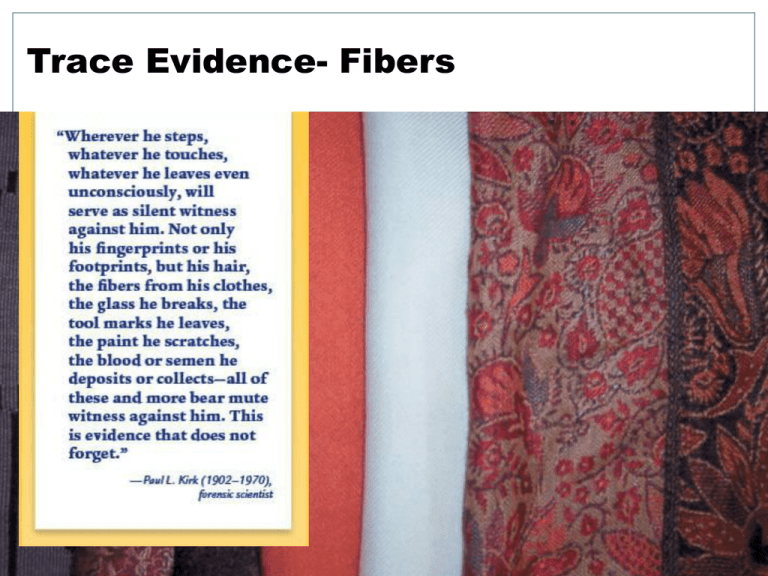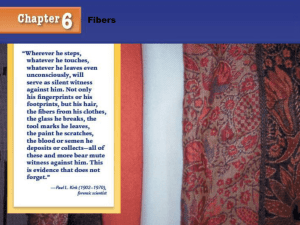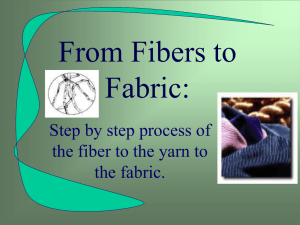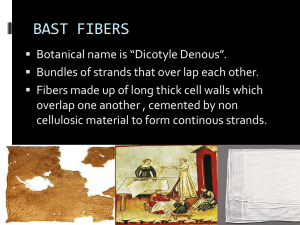File
advertisement

Trace Evidence- Fibers Wayne Williams- Fiber Evidence https://www.youtube.com/watch?v=JJuK98UYt4k 16:50- 25:00 Polymers 3 Fibers are made of polymers, which are long chains of repeating chemical units (monomers) The word polymer means many (poly) units (mer). By varying the chemical structure of the monomers or by varying the way they are joined together, polymers are created that have different properties. As a result of these differences, they can be distinguished from one another forensically. Kendall/Hunt Publishing Company Fibers - Fibers are considered class evidence - Have probative value (evidence which is sufficiently useful to prove something important in trial) - Are common trace evidence found at a crime scene - Can be characterized based on comparison of both physical and chemical properties Fabrics Fabric is made of fibers composed of twisted filaments. Types of fibers and fabric: Natural—animal, vegetable, or inorganic Artificial—synthesized or created from altered natural sources Types of Fibers Synthetic Natural Rayon Silk Nylon Cotton Acetate Wool Acrylic Mohair Spandex Cashmere Polyester Kendall/Hunt Publishing Company Classification 7 Natural fibers are classified according to their origin: - Vegetable or cellulose - Animal or protein - Mineral Kendall/Hunt Publishing Company Cellulose Fibers Cotton—the most common plant (vegetable) fiber is simply a polymer of cellulose. Cotton is strong, tough, flexible, moistureabsorbent, not shape-retentive . Kendall/Hunt Publishing Company Cellulose Fibers Rayon—(Regenerated Fiber) chemically altered cellulose; soft, lustrous, versatile Kendall/Hunt Publishing Company Cellulose Fibers Cellulose acetate— (Regenerated Fiber) cellulose that is chemically altered to create an entirely new compound not found in nature. Kendall/Hunt Publishing Company Fiber Comparison Can you describe the difference(s) between the cotton on the left and the rayon on the right? 11 Protein Fibers Wool—animal fiber coming most often from sheep, but may be goat (mohair), rabbit (angora), camel, alpaca, llama, or vicuña. Wool is primarily keratin. What is keratin? Both silk and wool consist of fibrous proteins made up of amino acid monomers. Wool tends to have a kinky appearance, itchy feel and is wrinkle resistant. Kendall/Hunt Publishing Company 12 Protein Fibers Silk—insect fiber that is extruded by silkworms in long filaments- up to a mile long. Silk has insulating properties, is able to wick moisture away and is soft to the touch. Kendall/Hunt Publishing Company 13 Protein Fibers Kendall/Hunt Publishing Company 14 Mineral Fibers Asbestos—a natural fiber that has been used in fire-resistant substances Rock wool—a manufactured mineral fiber Fiberglass—a manufactured inorganic fiber Kendall/Hunt Publishing Company Synthetic Fibers Made from derivatives of petroleum, coal, and natural gas 16 Nylon—most durable of man-made fibers; extremely lightweight Polyester—most widely used man-made fiber Acrylic—provides warmth from a lightweight, soft, and resilient fiber Spandex—extreme elastic properties Kendall/Hunt Publishing Company Filament Cross Sections Round 4-lobed Octalobal Trilobal Irregular Dogbone or Dumbbell Multi-lobed or Serrate Synthetic fibers are forced out of a nozzle when they are hot, and then they are woven. The holes of the nozzle are not necessarily round; therefore, the fiber filament may have a unique shape in cross section. Kendall/Hunt Publishing Company 17 Fabric Characteristics All unique to type of Types of fibers fabric Loop pattern Degree of stretch Knitted Woven Bonded Crocheted Felted Knotted Laminated Absorbency Water repellence Softness Durability Testing for Identification Microscopic observation Burning—observation of how a fiber burns, the odor, color of flame, color of smoke, and the appearance of the residue Thermal decomposition— gently heating to break down the fiber to the basic monomers Chemical tests—solubility and decomposition Kendall/Hunt Publishing Company Testing for Identification Density—the mass of an object divided by the volume of the object Refractive index— measurement of the bending of light as it passes from air into a solid or liquid Fluorescence—absorption and reemission of light; used for comparing fibers as well as spotting fibers for collection Kendall/Hunt Publishing Company Burn Test Record the number of the swatch next to the appropriate fiber type. In Flame: Burns and chars Burns and chars Melts and burns Melts and burns Out of Flame: Stops burning Keeps burning Stops burning Keeps burning Residue: Crushable bead Ash Plastic bead Plastic bead Odor: Burning hair Burning paper Acrid chemical Acrid chemical FIBER IDENTITY Proteins: Silk Wool Cotton Rayon Synthetic: Nylon Polyester Regenerated synthetic: Acetate Kendall/Hunt Publishing Company Dyes Components that make up dyes can be separated and matched to an unknown. There are more than 7,000 different dye formulations. Chromatography is used to separate dyes to give a more detailed analysis of the dye composition Kendall/Hunt Publishing Company Collection of Fiber Evidence Bag clothing items individually in paper bags. Make sure that different items are not placed on the same surface before being bagged. Why is this important? Make tape lifts of exposed skin areas and any inanimate objects. Removed fibers should be folded into a small sheet of paper and stored in a paper bag. Kendall/Hunt Publishing Company Fiber Evidence Fiber evidence in court cases can be used to connect the suspect to the victim or to the crime scene. In the case of Wayne Williams, fibers weighed heavily on the outcome of the case. Williams was convicted in 1982 based on carpet fibers that were found in his home, in his car, and on several murder victims. Kendall/Hunt Publishing Company











